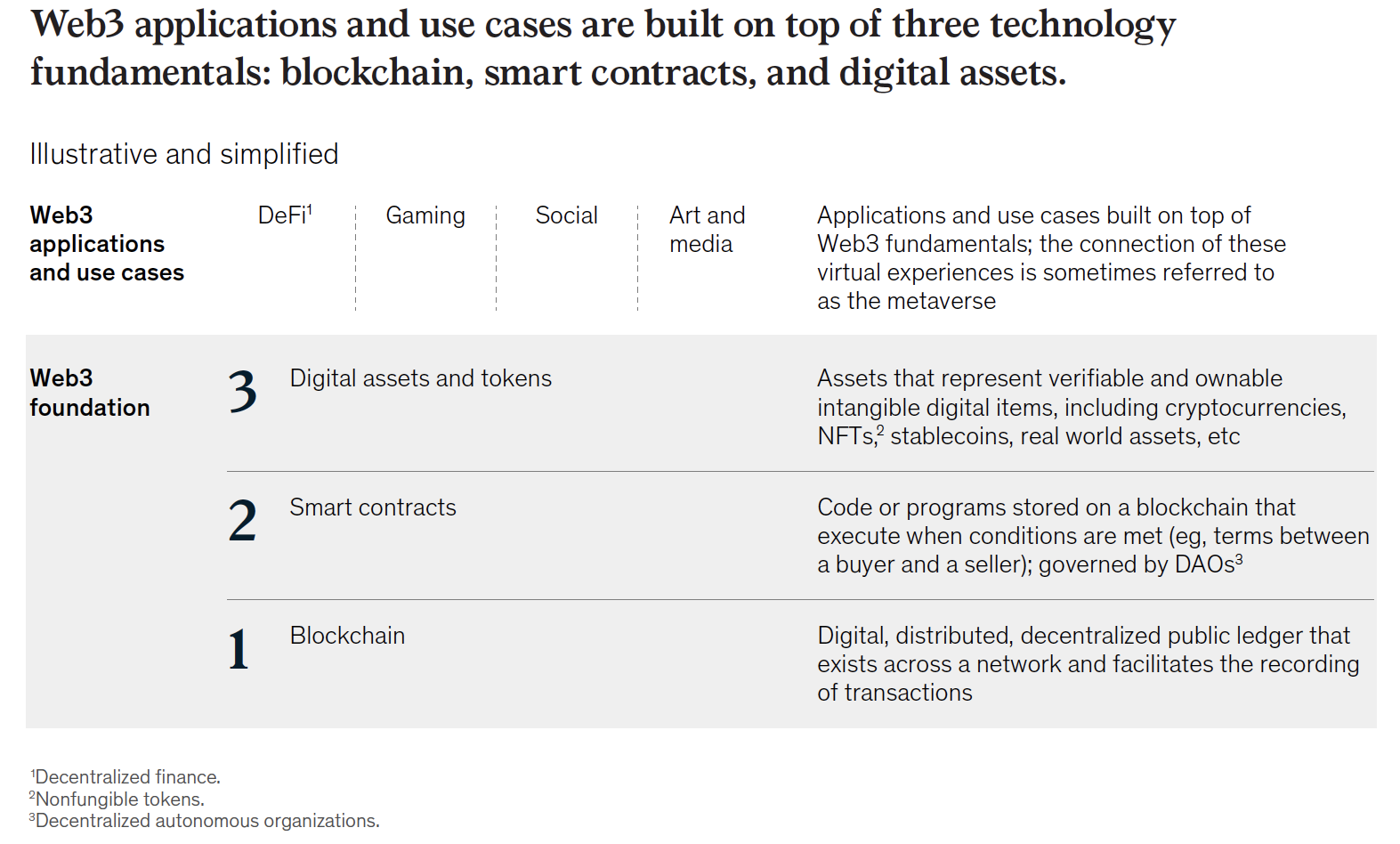
READ MORE: Web3 Beyond the hype (McKinsey & Co.)
Is Web3 crumbling? After a rocky few months in which crypto currencies have tumbled in value, there are huge questions that need to be resolved if Web3 is to ever reach mass adoption.
Regulatory oversight, user experience, and the underlying technology will all need to further mature before it can fully establish itself.
The analysts at McKinsey & Co. are here to shore up support.
“The value proposition for consumers at the heart of Web3 — is a powerful one,” the consultancy underscores in a new white paper titled “Web3 Beyond the hype.”
So powerful, in fact, that ignoring the potential of Web3 is more of a risk for business than getting on board with the tech in the first place.
McKinsey insists business leaders shouldn’t confuse market “fluctuations or bad actors” with the potential uses of digital assets and the technologies that underlie them.
“While there are very real risks from this nascent technology and its uses, applications for the next generation of the internet continue to spring up in a growing number of industries with potentially transformative effects.”
So let’s remind ourselves of the promise of the third phase of the internet.

Web3 is — in theory — underpinned by new and open financial standards, protocols and organizational structures encompassing everything we do online. Crucially, control is no longer centralized in large platforms and aggregators, but widely distributed through decentralized blockchains and smart contracts.
“Web3 potentially upends the existing power structure with a shift back to users,” McKinsey says.
Governance — and this is one of the trickiest aspects of Web3 — is meant to take place in the community rather than behind closed doors. Revenues can be given back to creators and users with some incentives to finance user acquisition and growth.
Yet in recent months Web3 enthusiasts have had a “rough awakening,” McKinsey notes. The market prices of major cryptocurrencies have declined significantly, the trading volume of non-fungible tokens (NFTs) has slowed, and, most importantly, some pioneers of the space have declared bankruptcy because of failed risk management and misuse of consumer funds.
The paper examines the main challenges ahead if Web3 is to achieve this dream.
The chief headwind is regulatory scrutiny. According to McKinsey, regulators in many countries are looking to issue new guidance for Web3 that balances the risks and the innovative potential, but the picture remains unsettled.
“For now, there is a lack of clarity — and jurisdictional consistency — about classifying these assets, services, and governance models. For example, smart contracts are not yet legally enforceable.”
“Web3 is a building block for an interoperable metaverse, an entirely virtual parallel universe under construction that is attracting massive investment from consumer companies and VCs, among others.”
— McKinsey & Co.
This in turn limits the potential for institutional adoption. Governance remains a work in progress, and the integrity of decentralized autonomous organizations (DAOs) — the collective community mechanisms that are supposed to oversee this new decentralized world — ”varies widely and is often not yet rock-solid.”
There are more hurdles. The user experience in this new ecosystem is not yet ready for mainstream adoption.
“Interfaces are often poorly designed, and the underlying technology is still too cumbersome for users to have a seamless experience.”
Security is another concern. “Until users have peace of mind, they will likely not adopt this technology en masse. Fraud continues to be a risk, with a variety of ‘rug pulls,’ Ponzi schemes, and social-engineering scams dogging the nascent sector, while know-your-customer and anti-money laundering procedures are often lacking.”
A prominent concern is that users engaged in Web3 may not fully understand the risks of decentralized technology, “thus expecting the same type of protections they are used to from centralized (and often regulated) entities.”
For example, transactions on the blockchain, by their very nature, are irreversible, so the concept of clawbacks or user fund retrieval does not currently exist (although it is technically possible).
Transaction cost is also a factor, making some of the technology protocols too expensive to use at present. For example, fees paid to complete and record a transaction on the Ethereum blockchain (so-called gas fees) could be prohibitive for users in large parts of the world, the analyst finds.
“Smart-contract resilience is unproven, with new exploits of weaknesses in new code or ‘logic hacks’ happening weekly, and the accuracy of ‘oracles’—that is, information feeds that are used in decisioning by smart contracts — continues to be a work in progress.”
Finally, given their environmental footprint, proof-of-work blockchains could present specific adoption challenges for corporations, and regulators, at a time of growing attention to environmental, social and governance issues.
That seems like a lot of steep mountains to climb — but McKinsey insists that Web3’s disruptive potential remains an important internet trend to watch.
“C-suite executives may want to keep it on their radar, if only because of the potential for rapid disruption that it represents.”
“Until users have peace of mind, they will likely not adopt this technology en masse. Fraud continues to be a risk, with a variety of ‘rug pulls,’ Ponzi schemes, and social-engineering scams dogging the nascent sector, while know-your-customer and anti-money laundering procedures are often lacking.”
— McKinsey & Co.
It reports that leading Web3 players are aware of these challenges and are actively working to address them, often funded by extensive venture capital. Indeed, VC investments in Web3 exceeded $18 billion in the first half of 2022, remaining on track to top the full-year total VC investments of $32.4 bn in 2021.
McKinsey advises, “Executives could develop a deliberate strategy by asking how Web3 native companies could disrupt their industry and what challenges and opportunities this might present.”
Despite the recent market downturn, the speed of innovation is unlikely to slow.
We are already starting to see the emergence of Web3 native marketplaces, payment networks, and deposit and loan platforms. The emergence of Web3 gaming, social, and media platforms — the Web3 metaverse — could be next.
“Web3 is a building block for an interoperable metaverse, an entirely virtual parallel universe under construction that is attracting massive investment from consumer companies and VCs, among others.”
Thousands of new developers are joining the Web3 movement every month, McKinsey reports. Given the open-source nature of the technology, developers can easily develop new applications by building on established programs.
“It may be hard for even the largest organizations to compete with this scale of global developer base and innovation, and the speed could accelerate as more users and developers join,” it warns.
“Executives could develop a deliberate strategy by asking how Web3 native companies could disrupt their industry and what challenges and opportunities this might present.”
— McKinsey & Co.
What’s more engagement is growing, especially for younger generations.
In a recent McKinsey survey of 35,000 active online users in some of the largest digital-asset markets — India, Singapore, the UK and US — 20% of respondents age 25 to 44 said they own digital assets. Two-thirds of those had already made payments using digital assets (presumably for peer-to-peer payments or Web3 commerce) and just over half had used NFTs as a form of digital identity or performed play-to-earn activities with digital assets.
“As with any new technologies billed as disruptive, it remains to be seen just how revolutionary blockchain, smart contracts, and digital assets will prove to be. While skepticism is significant among some parts of the public, especially following the steep declines in the valuation of digital assets and the recent bankruptcies of some funds and consumer deposit companies, user interest remains high.”
The technology itself may not be ready for mainstream adoption — but the Web3 dream remains alive.
YOUR ROADMAP TO WEB3:
Does Web3 offer the promise of a truly decentralized internet, or is it just another way for Big Tech to maintain its stranglehold on our personal data? Hand-picked from the NAB Amplify archives, here are the expert insights you need to understand Web3’s potential and stay ahead of the curve on the information superhighway:
- The Web3 Dream vs. Digital (and Economic) Realities
- What Needs to Happen for Web3 to Go Mainstream
- Web3 and the Future of Work (Oh, Guess What? It’s Decentralized.)
- Web3, Free Will and Who Will Own the Future
- Taking Those First Steps Into Web3


